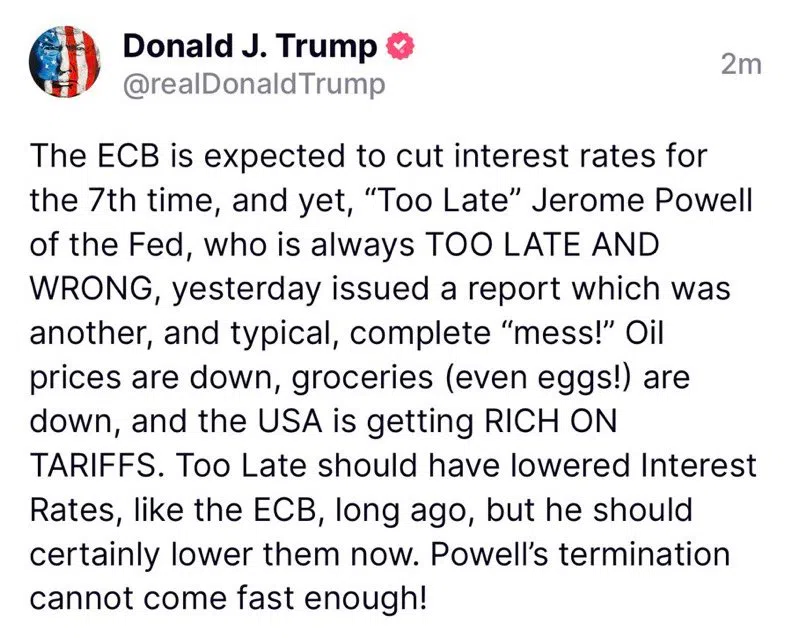Trump insists he could fire independent US Fed chairman Powell
Sign up now: Get ST's newsletters delivered to your inbox

Trump-appointed Jerome Powell insists he has no plans to step down as US Federal Reserve chairman before his term ends in 2026.
PHOTO: AFP
Follow topic:
WASHINGTON – US President Donald Trump on April 17 insisted that he could force out the head of the independent Federal Reserve, lashing out after Mr Jerome Powell warned of tariff-fuelled inflation.
Speaking to reporters at the White House, Mr Trump said Mr Powell would “leave if I ask him to”.
The President added: “I’m not happy with him. I let him know it and if I want him out, he’ll be out of there real fast, believe me.”
Earlier, in a scathing post on his Truth Social platform, Mr Trump repeated a demand for Mr Powell to lower interest rates, saying his “termination... cannot come fast enough”.
Sources also told The Wall Street Journal that Mr Trump has privately discussed firing Mr Powell for months but has not made a final decision, and raised it during private meetings at Mar-a-Lago with former Fed governor Kevin Warsh.
The US President does not have direct authority to fire Federal Reserve governors, but Mr Trump could initiate a lengthy process to attempt to unseat Mr Powell by proving there was “cause” to do so.
Mr Powell warned on April 16 that Mr Trump’s sweeping tariffs on virtually every trade partner could put the Fed in the unenviable position of having to choose between tackling inflation and unemployment.

SCREENSHOT: X
Mr Trump’s stop-start tariff policy has unnerved investors and governments around the world, leaving them unsure about his long-term strategy and what it might mean for international trade.
The US central bank has adopted a wait-and-see attitude to cutting rates, holding them steady at 4.25 per cent to 4.5 per cent since the start of 2025.
Mr Trump has frequently criticised the Fed chairman, whom he originally nominated during his first term, accusing Mr Powell of playing politics.
Mr Trump’s earlier post suggested Mr Powell’s decisions were “Too Late” and that he should have followed the European Central Bank’s (ECB) lead, which on April 17 lowered its benchmark deposit rate
ECB chief Christine Lagarde expressed her confidence in Mr Powell following Mr Trump’s remarks, saying she had “a lot of respect for my friend and esteemed colleague”.
On the campaign trail in August 2024, Mr Trump suggested the White House should have a “say” in setting monetary policy.
Democrats, however, have defended the independence of the institution.
“An independent Fed is vital for a healthy economy – something that Trump has proved is not a priority for him,” senior Democratic Senator Chuck Schumer said on X in response to Mr Trump’s criticism of Mr Powell.
Powell pledges to stay
While presidents have a long history of clashing with Fed chiefs, any move to force Mr Powell to leave office would be unprecedented in modern US political history.
Speaking on April 4, Mr Powell insisted he had no plans to step down as Fed chairman before his term ends in 2026.
“I fully intend to serve all of my term,” he said at an event in Virginia.
At the time, Mr Powell also suggested that the Fed was in no rush to cut its benchmark lending rate from its current elevated level.
Financial markets see a roughly two-thirds chance that policymakers will vote to keep rates unchanged again at the next Fed interest rate meeting in May, according to data from CME Group.
Setting key interest rates is one of the primary levers the Fed exercises in its dual mandate of managing inflation and unemployment.
Lowering interest rates serves to make borrowing cheaper and tends to kick-start the economy by encouraging investment, while raising them – or keeping them steady at higher rates – can help cool inflation.
US year-on-year consumer inflation slowed to 2.4 per cent in March, bringing it closer to the Fed’s long-term 2 per cent target.
That drop was aided by a 6.3 per cent fall in petrol prices, according to official data. AFP

